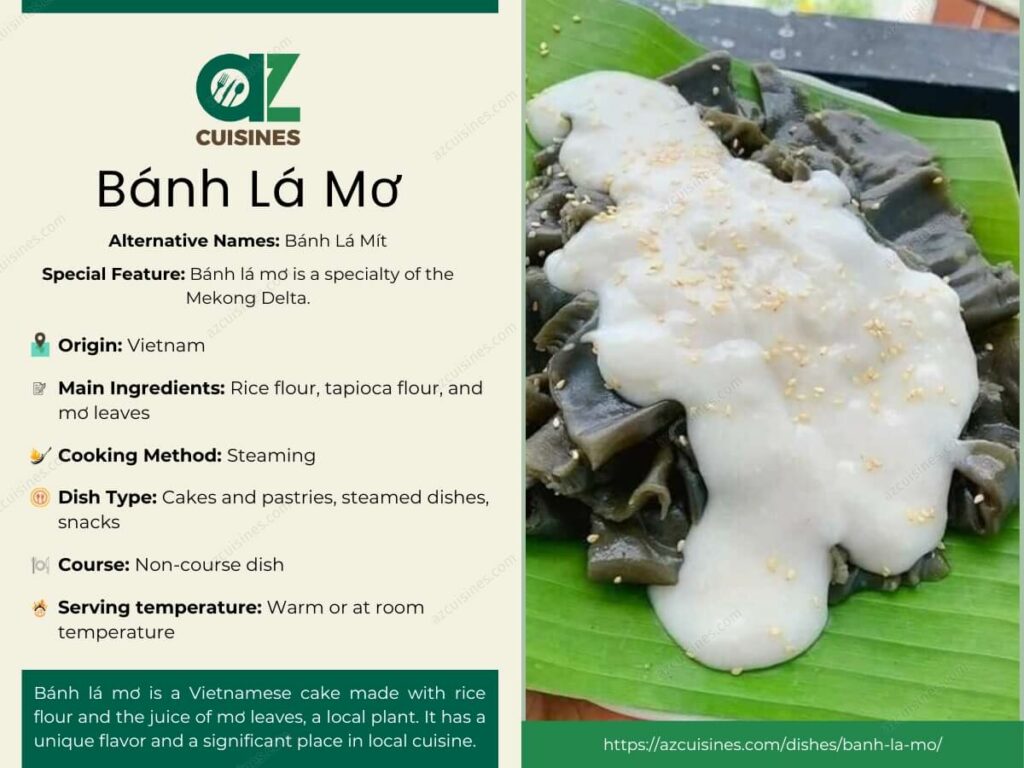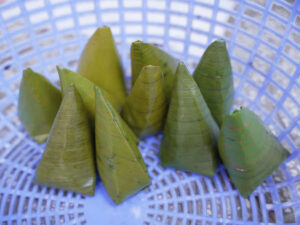#138 in Vietnam
Bánh Lá Mơ: Basic Information
Pronunciation
Alternative Name(s)
Dish Type
Course
Mealtime
Popular Variations
Bánh Lá Mơ: Ingredients and Preparation
Main Ingredients
Main Cooking Method
Preparation Process
Bánh Lá Mơ: A Deep Dive
Cultural Significance
Taste
Texture
Aroma
Color
Serving Style
Serving Temperature
Accompaniment
Occasions
Seasons
Special Diets
Calories
Popularity
Popular Similar Dishes
Popular Dining Area
Bánh lá mơ is a traditional Vietnamese steamed cake found in the Mekong Delta. It is made from rice flour, tapioca flour, sugar, and juice extracted from the leaves of the mơ or mơ lông plant (Paederia lanuginosa).
People prepare bánh lá mơ by spreading a thin layer of dough on a jackfruit or banana leaf, steaming it, then removing the cake and serving it with coconut milk, toasted sesame seeds, and roasted peanuts.
The mơ plant is sometimes called by the interesting name cây thúi địch (“farting plant”) due to the distinct smell the leaves release when being crushed.
However, bánh lá mơ has an addictive flavor that is unlike regular sweets. Due to the wrappings, this cake is also called bánh lá mít (“cake in jackfruit leaves”).
Read on to discover more interesting facts about this exotic Vietnamese cake and street food, such as its advantages, disadvantages, and common concerns. I will also suggest similar dishes for further experiences with Vietnamese cakes.
Key Points
Pros and Cons of Eating Bánh Lá Mơ
Bánh lá mơ comes with the following strengths and weaknesses.
Pros
Cons
After learning about these advantages and disadvantages, why don’t you check out the FAQs section to discover other aspects of bánh lá mơ?





Truc Tran (Kris)
Senior Food Editor
Expertise
Home Cooking, Meal Planning, Recipe Development, Baking and Pastry, Food Editor, Cooking-video Maker, Vietnamese Food Evaluation Expert
Education
Truc Tran (Kris), an experienced food writer and editor, is great at exploring and describing global cuisines, from simple street food to fancy dining. In her writing, she skillfully mixes different flavors, cooking methods, and culinary traditions, showing the unique character of various cultures through their food and drinks. On azcuisines.com, Kris highlights her knowledge, especially in Asian cuisine and worldwide traditional dishes.